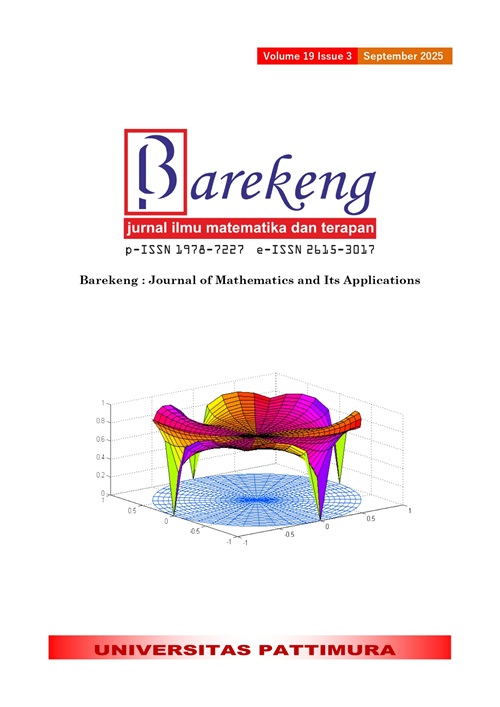PERFORMANCE LOSS QUANTIFICATION IN KERNEL DENSITY ESTIMATION FOR ACTUARIAL AND FINANCIAL ANALYSIS
Abstract
Accurately estimating aggregate loss distributions is critical in actuarial and financial risk assessment, as it underpins effective risk analysis and the development of mitigation strategies. However, incorrect parametric assumptions can lead to biased risk estimates and underestimated losses. Non-parametric methods, such as Kernel Density Estimation (KDE), offer a flexible alternative by generating smooth empirical probability density functions (PDFs) directly from sample data without assuming a specific distributional form. This study examines the impact of dependence structures on risk measures by applying KDE with a Gaussian kernel to estimate aggregate loss distributions. To quantify the effects of ignoring dependence, we introduce the concept of performance loss, focusing on variance, Value at Risk (VaR), and Tail Value at Risk (TVaR). The results show that performance loss increases with the correlation coefficient, indicating that higher dependency leads to greater underestimation of risk. Additionally, higher confidence levels amplify performance loss for VaR and TVaR, underscoring the sensitivity of these measures to tail behavior. These findings highlight the importance of incorporating dependence structures in risk modeling to avoid misleading evaluations. The implications are particularly relevant for disaster risk management in Central Asia, where overlooking interdependencies in seismic losses could result in inadequate financial and actuarial strategies.
Downloads
References
A. Naqvi and I. Monasterolo, “ASSESSING THE CASCADING IMPACTS OF NATURAL DISASTERS IN A MULTI-LAYER BEHAVIORAL NETWORK FRAMEWORK,” Sci Rep, vol. 11, no. 1, p. 20146, Oct. 2021, doi: https://doi.org/10.1038/s41598-021-99343-4.
K. Goda and J. Ren, “ASSESSMENT OF SEISMIC LOSS DEPENDENCE USING COPULA,” Risk Analysis, vol. 30, no. 7, pp. 1076–1091, Jul. 2010, doi: https://doi.org/10.1111/j.1539-6924.2010.01408.x.
J. Wu, X. He, M. Ye, and C. Wang, “ENERGY AND ASSET VALUE ELASTICITY OF EARTHQUAKE-INDUCED DIRECT ECONOMIC LOSSES,” International Journal of Disaster Risk Reduction, vol. 33, pp. 229–234, Feb. 2019, doi: https://doi.org/10.1016/j.ijdrr.2018.10.008.
T. Jin, S. B. Provost, and J. Ren, “MOMENT-BASED DENSITY APPROXIMATIONS FOR AGGREGATE LOSSES,” Scand Actuar J, vol. 2016, no. 3, pp. 216–245, Mar. 2016, doi: https://doi.org/10.1080/03461238.2014.921640.
M. Ghafory-Ashtiany and H. Motamed, “EARTHQUAKE INSURANCE IN IRAN: SOLVENCY OF LOCAL INSURERS IN LIGHT OF CURRENT MARKET PRACTICES,” Natural Hazards and Earth System Sciences, vol. 24, no. 8, pp. 2707–2726, Aug. 2024, doi: https://doi.org/10.5194/nhess-24-2707-2024.
J. Gustafsson, M. Hagmann, J. P. Nielsen, and O. Scaillet, “LOCAL TRANSFORMATION KERNEL DENSITY ESTIMATION OF LOSS DISTRIBUTIONS,” Journal of Business and Economic Statistics, vol. 27, no. 2, pp. 161–175, 2009, doi: https://doi.org/10.1198/jbes.2009.0011.
V. Witkovsky, G. Wimmer, and T. Duby, “COMPUTING THE AGGREGATE LOSS DISTRIBUTION BASED ON NUMERICAL INVERSION OF THE COMPOUND EMPIRICAL CHARACTERISTIC FUNCTION OF FREQUENCY AND SEVERITY,” Jan. 2017.
P. J. de Jongh, T. de Wet, H. Raubenheimer, and J. H. Venter, “COMBINING SCENARIO AND HISTORICAL DATA IN THE LOSS DISTRIBUTION APPROACH: A NEW PROCEDURE THAT INCORPORATES MEASURES OF AGREEMENT BETWEEN SCENARIOS AND HISTORICAL DATA,” The Journal of Operational Risk, vol. 10, no. 1, pp. 45–76, Mar. 2015, doi: https://doi.org/10.21314/JOP.2015.160.
T. Trimono and D. A. Maruddani, “COMPARISON BETWEEN VALUE AT RISK AND ADJUSTED EXPECTED SHORTFALL: A NUMERICAL ANALYSIS,” BAREKENG: Jurnal Ilmu Matematika dan Terapan, vol. 17, no. 3, pp. 1347–1358, Sep. 2023, doi: https://doi.org/10.30598/barekengvol17iss3pp1347-1358.
P. Ramírez-Cobo, E. Carrizosa, and R. E. Lillo, “ANALYSIS OF AN AGGREGATE LOSS MODEL IN A MARKOV RENEWAL REGIME,” Appl Math Comput, vol. 396, p. 125869, May 2021, doi: https://doi.org/10.1016/j.amc.2020.125869.
H. Yonar, N. Iyit, and A. Prof, “EARTHQUAKE RISK ASSESSMENT BY USING COLLECTIVE RISK MODELS,” International Journal of Research & Review (www.ijrrjournal.com), vol. 4, p. 12, 2017, [Online]. Available: www.ijrrjournal.com
R. Oh, Y. Lee, D. Zhu, and J. Y. Ahn, “PREDICTIVE RISK ANALYSIS USING A COLLECTIVE RISK MODEL: CHOOSING BETWEEN PAST FREQUENCY AND AGGREGATE SEVERITY INFORMATION,” Insur Math Econ, vol. 96, pp. 127–139, Jan. 2021, doi: https://doi.org/10.1016/j.insmatheco.2020.11.002.
R. Oh, Y. Lee, D. Zhu, and J. Y. Ahn, “PREDICTIVE RISK ANALYSIS IN COLLECTIVE RISK MODEL: CHOICES BETWEEN HISTORICAL FREQUENCY AND AGGREGATE SEVERITY,” Feb. 2020.doi: https://doi.org/10.1016/j.insmatheco.2020.11.002
C. Blier-Wong, H. Cossette, and E. Marceau, “COLLECTIVE RISK MODELS WITH FGM DEPENDENCE,” Sep. 2022, [Online]. Available: http://arxiv.org/abs/2209.13543
T. W. Kwan and H. K. N. Leung, “A RISK MANAGEMENT METHODOLOGY FOR PROJECT RISK DEPENDENCIES,” IEEE Transactions on Software Engineering, vol. 37, no. 5, pp. 635–648, Sep. 2011, doi: https://doi.org/10.1109/TSE.2010.108.
S. Węglarczyk, “KERNEL DENSITY ESTIMATION AND ITS APPLICATION,” ITM Web of Conferences, vol. 23, p. 00037, Nov. 2018, doi: https://doi.org/10.1051/itmconf/20182300037.
J.-Q. Chen, Y.-L. He, Y.-C. Cheng, P. Fournier-Viger, and J. Z. Huang, “A MULTIPLE KERNEL-BASED KERNEL DENSITY ESTIMATOR FOR MULTIMODAL PROBABILITY DENSITY FUNCTIONS,” Eng Appl Artif Intell, vol. 132, p. 107979, Jun. 2024, doi: https://doi.org/10.1016/j.engappai.2024.107979.
B. HU, Y. LI, H. YANG, and H. WANG, “WIND SPEED MODEL BASED ON KERNEL DENSITY ESTIMATION AND ITS APPLICATION IN RELIABILITY ASSESSMENT OF GENERATING SYSTEMS,” Journal of Modern Power Systems and Clean Energy, vol. 5, no. 2, pp. 220–227, Mar. 2017, doi: ttps://doi.org/10.1007/s40565-015-0172-5.
M.-T. Pelz, M. Schartau, C. J. Somes, V. Lampe, and T. Slawig, “A DIFFUSION-BASED KERNEL DENSITY ESTIMATOR (DIFFKDE, VERSION 1) WITH OPTIMAL BANDWIDTH APPROXIMATION FOR THE ANALYSIS OF DATA IN GEOSCIENCE AND ECOLOGICAL RESEARCH,” Geosci Model Dev, vol. 16, no. 22, pp. 6609–6634, Nov. 2023, doi: https://doi.org/10.5194/gmd-16-6609-2023.
Z. Yuan, M. J. Jarvis, and J. Wang, “A FLEXIBLE METHOD FOR ESTIMATING LUMINOSITY FUNCTIONS VIA KERNEL DENSITY ESTIMATION,” Astrophys J Suppl Ser, vol. 248, no. 1, p. 1, May 2020, doi: https://doi.org/10.3847/1538-4365/ab855b.
Z. I. Botev, J. F. Grotowski, and D. P. Kroese, “KERNEL DENSITY ESTIMATION VIA DIFFUSION,” Ann Stat, vol. 38, no. 5, pp. 2916–2957, Oct. 2010, doi: https://doi.org/10.1214/10-AOS799.
A. Azzalini, “A NOTE ON THE ESTIMATION OF A DISTRIBUTION FUNCTION AND QUANTILES BY A KERNEL METHOD DOWNLOADED FROM,” 1981. [Online]. Available: http://biomet.oxfordjournals.org/
L. Breiman, W. Meisel, and E. Purcell, “VARIABLE KERNEL ESTIMATES OF MULTIVARIATE DENSITIES,” Technometrics, vol. 19, no. 2, p. 135, May 1977, doi: https://doi.org/10.2307/1268623.
M. Lux, W. K. Härdle, and S. Lessmann, “DATA DRIVEN VALUE-AT-RISK FORECASTING USING A SVR-GARCH-KDE HYBRID,” Comput Stat, vol. 35, no. 3, pp. 947–981, Sep. 2020, doi: https://doi.org/10.1007/s00180-019-00934-7.
Y. Soh, Y. Hae, A. Mehmood, H. Ashraf, and I. Kim, “PERFORMANCE EVALUATION OF VARIOUS FUNCTIONS FOR KERNEL DENSITY ESTIMATION,” 2013. doi: ttps://doi.org/10.4236/ojapps.2013.31B012
S. Lauterbach, J. Mingram, G. Schettler, and S. Orunbaev, “TWO TWENTIETH-CENTURY M LH = 7.5 EARTHQUAKES RECORDED IN ANNUALLY LAMINATED LAKE SEDIMENTS FROM SARY CHELEK, WESTERN TIAN SHAN, KYRGYZSTAN,” Quat Res, vol. 92, no. 2, pp. 288–303, Sep. 2019, doi: https://doi.org/10.1017/qua.2019.21.
Shahid Ullah et al., “PROBABILISTIC SEISMIC HAZARD ASSESSMENT FOR CENTRAL ASIA,” Annals of Geophysics, vol. 58, no. 1, Apr. 2015, doi: https://doi.org/10.4401/ag-6687.
V. Poggi et al., “HARMONIZING SEISMICITY INFORMATION IN CENTRAL ASIAN COUNTRIES: EARTHQUAKE CATALOGUE AND ACTIVE FAULTS,” Natural Hazards and Earth System Sciences, vol. 24, no. 7, pp. 2597–2613, Jul. 2024, doi: https://doi.org/10.5194/nhess-24-2597-2024.
Shahid Ullah et al., “PROBABILISTIC SEISMIC HAZARD ASSESSMENT FOR CENTRAL ASIA,” Annals of Geophysics, vol. 58, no. 1, Apr. 2015, doi: https://doi.org/10.4401/ag-6687.
R. Sun, G. Gao, Z. Gong, and J. Wu, “A REVIEW OF RISK ANALYSIS METHODS FOR NATURAL DISASTERS,” Natural Hazards, vol. 100, no. 2, pp. 571–593, Jan. 2020, doi: https://doi.org/10.1007/s11069-019-03826-7.
H. B. Havenith, I. Torgoev, and A. Ischuk, “INTEGRATED GEOPHYSICAL-GEOLOGICAL 3D MODEL OF THE RIGHT-BANK SLOPE DOWNSTREAM FROM THE ROGUN DAM CONSTRUCTION SITE, TAJIKISTAN,” International Journal of Geophysics, vol. 2018, 2018, doi: https://doi.org/10.1155/2018/1641789.
A. Nurmagambetov, N. Mikhailova, and W. Iwan, “SEISMIC HAZARD OF THE CENTRAL ASIA REGION,” in Seismic Hazard and Building Vulnerability in Post-Soviet Central Asian Republics, Dordrecht: Springer Netherlands, 1999, pp. 1–43. doi: https://doi.org/10.1007/978-94-017-2971-0_1.
Shahid Ullah et al., “PROBABILISTIC SEISMIC HAZARD ASSESSMENT FOR CENTRAL ASIA,” Annals of Geophysics, vol. 58, no. 1, Apr. 2015, doi: https://doi.org/10.4401/ag-6687.
M. A. Salgado-Gálvez et al., “DEVELOPMENT OF A REGIONALLY CONSISTENT AND FULLY PROBABILISTIC EARTHQUAKE RISK MODEL FOR CENTRAL ASIA,” Natural Hazards and Earth System Sciences, vol. 24, no. 11, pp. 3851–3868, Nov. 2024, doi: https://doi.org/10.5194/nhess-24-3851-2024.
S. Mohadjer, T. A. Ehlers, R. Bendick, K. Stübner, and T. Strube, “A QUATERNARY FAULT DATABASE FOR CENTRAL ASIA,” Natural Hazards and Earth System Sciences, vol. 16, no. 2, pp. 529–542, Feb. 2016, doi: https://doi.org/10.5194/nhess-16-529-2016.
V. Poggi et al., “HARMONIZING SEISMICITY INFORMATION IN CENTRAL ASIAN COUNTRIES: EARTHQUAKE CATALOGUE AND ACTIVE FAULTS,” Natural Hazards and Earth System Sciences, vol. 24, no. 7, pp. 2597–2613, Jul. 2024, doi: https://doi.org/10.5194/nhess-24-2597-2024.
M. Akhmedov and R. Abirov, “MITIGATION OF SEISMIC RISK IN URBAN ZONES OF UZBEKISTAN AS PATH FOR STRENGTHENING OF SUSTAINABLE DEVELOPMENT OF REGION,” in Proceedings of the International Scientific and Practical Conference on Sustainable Development of Regional Infrastructure, SCITEPRESS - Science and Technology Publications, 2021, pp. 16–22. doi: ttps://doi.org/10.5220/0010585400160022.
S. Parolai et al., “ASSESSING EARTHQUAKE EARLY WARNING USING SPARSE NETWORKS IN DEVELOPING COUNTRIES: CASE STUDY OF THE KYRGYZ REPUBLIC,” Front Earth Sci (Lausanne), vol. 5, Sep. 2017, doi: https://doi.org/10.3389/feart.2017.00074.
N. G. Mavlyanova, V. A. Lipatov, and J. P. Tiefenbacher, “REGIONAL COOPERATIVE DISASTER RISK MANAGEMENT IN CENTRAL ASIAN BORDERLANDS,” J Borderl Stud, vol. 38, no. 3, pp. 417–439, May 2023, doi: ttps://doi.org/10.1080/08865655.2021.1943493.
F. Farokhi, “Deconvoluting kernel density estimation and regression for locally differentially private data,” Sci Rep, vol. 10, no. 1, Dec. 2020, doi: https://doi.org/10.1038/s41598-020-78323-0.
S. Chen, “OPTIMAL BANDWIDTH SELECTION FOR KERNEL DENSITY FUNCTIONALS ESTIMATION,” J Probab Stat, vol. 2015, pp. 1–21, 2015, doi: https://doi.org/10.1155/2015/242683.
N. Gündüz and C. Aydın, “OPTIMAL BANDWIDTH ESTIMATORS OF KERNEL DENSITY FUNCTIONALS FOR CONTAMINATED DATA,” J Appl Stat, vol. 48, no. 13–15, pp. 2239–2258, Nov. 2021, doi: https://doi.org/10.1080/02664763.2021.1944999.
C. Bolancé, M. Guillén, D. Pitt, and M. Guillen, “NON-PARAMETRIC MODELS FOR UNIVARIATE CLAIM SEVERITY DISTRIBUTIONS – AN APPROACH USING R,” 2014. [Online]. Available: www.ub.edu/riskcenter
K. M. Sakthivel and C. S. Rajitha, “KERNEL DENSITY ESTIMATION FOR CLAIM SIZE DISTRIBUTIONS USING SHIFTED POWER TRANSFORMATION,” 2016. [Online]. Available: www.ijsr.net
B. Khorramdel, C. Y. Chung, N. Safari, and G. C. D. Price, “A FUZZY ADAPTIVE PROBABILISTIC WIND POWER PREDICTION FRAMEWORK USING DIFFUSION KERNEL DENSITY ESTIMATORS,” IEEE Transactions on Power Systems, vol. 33, no. 6, pp. 7109–7121, Nov. 2018, doi: https://doi.org/10.1109/TPWRS.2018.2848207.
I. Klebanov, “AXIOMATIC APPROACH TO VARIABLE KERNEL DENSITY ESTIMATION,” May 2018, [Online]. Available: http://arxiv.org/abs/1805.01729
M. Zarrin, M. Abyani, and B. Asgarian, “A Statistical Study On Lognormal Central Tendency Estimation In Probabilistic Seismic Assessments,” Structure and Infrastructure Engineering, vol. 16, no. 5, pp. 803–819, May 2020, doi: https://doi.org/10.1080/15732479.2019.1668813.
C. Dollet, P. Guéguen, and A. Hernandez, “A COMPREHENSIVE SYNTHETIC DATABASE OF GLOBAL SEISMIC LOSSES COVERING THE PERIOD 1967–2018,” Bulletin of Earthquake Engineering, vol. 21, no. 9, pp. 4265–4288, Jul. 2023, doi: https://doi.org/10.1007/s10518-023-01695-x.
S. L. N. Jarder, O. Maruyama, and L. E. O. Garciano, “A Probabilistic Estimation Model For Seismic Physical Portfolio Loss Of A Water Supply Pipeline System,” Resilient Cities and Structures, vol. 3, no. 1, pp. 44–54, Mar. 2024, doi: https://doi.org/10.1016/j.rcns.2024.01.001.
M. Saïd, N. Ghazzali, and L.-P. Rivest, “SCORE TESTS FOR INDEPENDENCE IN PARAMETRIC COMPETING RISKS MODELS,” TEST, vol. 16, no. 3, pp. 547–564, Nov. 2007, doi: https://doi.org/10.1007/s11749-006-0019-5.
M. Saïd, N. Ghazzali, and L.-P. Rivest, “SCORE TESTS FOR INDEPENDENCE IN SEMIPARAMETRIC COMPETING RISKS MODELS,” Lifetime Data Anal, vol. 15, no. 4, pp. 413–440, Dec. 2009, doi: https://doi.org/10.1007/s10985-009-9123-7.
S. F. Untsa, N. Susyanto, D. T. Qoyyimi, and D. Ertiningsih, “PERFORMANCE LOSS IN DEPENDENT SEISMIC RISK MODELS,” Asia Pacific Journal of Mathematics, vol. 12, no. 23, 2025, doi: 10.28924/APJM/12-23.
N. Susyanto and C. Klaassen, “SEMIPARAMETRICALLY EFFICIENT ESTIMATION OF CONSTRAINED EUCLIDEAN PARAMETERS,” Electronic Journal of Statistics, vol. 11, no. 2, pp. 3120 – 3140, 2017, doi: https://doi.org/10.1214/17-EJS1308
Copyright (c) 2025 Shafira Fauzia Untsa, Nanang Susyanto, Danang Teguh Qoiyyimi, Dwi Ertiningsih

This work is licensed under a Creative Commons Attribution-ShareAlike 4.0 International License.
Authors who publish with this Journal agree to the following terms:
- Author retain copyright and grant the journal right of first publication with the work simultaneously licensed under a creative commons attribution license that allow others to share the work within an acknowledgement of the work’s authorship and initial publication of this journal.
- Authors are able to enter into separate, additional contractual arrangement for the non-exclusive distribution of the journal’s published version of the work (e.g. acknowledgement of its initial publication in this journal).
- Authors are permitted and encouraged to post their work online (e.g. in institutional repositories or on their websites) prior to and during the submission process, as it can lead to productive exchanges, as well as earlier and greater citation of published works.






1.gif)



